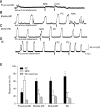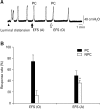Regional difference in colonic motility response to electrical field stimulation in Guinea pig
- PMID: 23667750
- PMCID: PMC3644655
- DOI: 10.5056/jnm.2013.19.2.192
Regional difference in colonic motility response to electrical field stimulation in Guinea pig
Abstract
Background/aims: In isolated guinea-pig colon, we investigated regional differences in peristalsis evoked by intrinsic electrical nerve stimulation.
Methods: Four colonic segments from mid and distal colon of Hartley guinea pigs, were mounted horizontally in an organ bath. Measurement of pellet propulsion time, intraluminal pressure, electrical field stimulation (EFS; 0.5 ms, 60 V, 10 Hz), and response of pharmacological antagonists, were performed to isolated segments of colon to determine the mechanisms underlying peristaltic reflexes evoked by focal electrical nerve stimuli.
Results: In fecal pellet propulsion study, the velocity of pellet propulsion was significantly faster in the distal colon and decreased gradually to the proximal part of the mid colon. Intraluminal pressure recording studies showed that luminal infusion initiated normal peristaltic contractions (PCs) in 82% trials of the distal colon, compared to that of mid colon. In response to EFS, the incidence of PCs was significantly increased in the distal colon in contrast, the incidence of non-peristaltic contractions (NPCs) was significantly higher in the middle-mid colon, distal-mid colon and distal colon, compared to that of proximal-mid colon. Addition of L-NAME into the bath increased the frequency of NPCs. EFS failed to cause any PCs or NPCs contractions in the presence of hexamethonium, atropine or tetrodotoxin.
Conclusions: This study has revealed that electrical nerve stimulation of distal colon is the most likely region to elicit a peristaltic wave, compared with the mid or proximal colon. Our findings suggest that EFS-evoked PCs can be modulated by endogenous nitric oxide.
Keywords: Anti-peristalsis; Colonic transit; Nitric oxide.
Conflict of interest statement
Conflicts of interest: None.
Figures






References
-
- Itoh Z. Motilin and clinical application. Peptides. 1997;18:593–608. - PubMed
-
- Ariga H, Tsukamoto K, Chen C, Mantyh C, Pappas TN, Takahashi T. Endogenous acyl ghrelin is involved in mediating spontaneous phase III-like contractions of the rat stomach. Neurogastroenterol Motil. 2007;19:675–680. - PubMed
-
- Zheng J, Ariga H, Taniguchi H, Ludwig K, Takahashi T. Ghrelin regulates gastric phase III-like contractions in freely moving conscious mice. Neurogastroenterol Motil. 2009;21:78–84. - PubMed
-
- Phillips SF. Functions of the large bowel: an overview. Scand J Gastroenterol Suppl. 1984;93:1–12. - PubMed
LinkOut - more resources
Full Text Sources
Other Literature Sources

